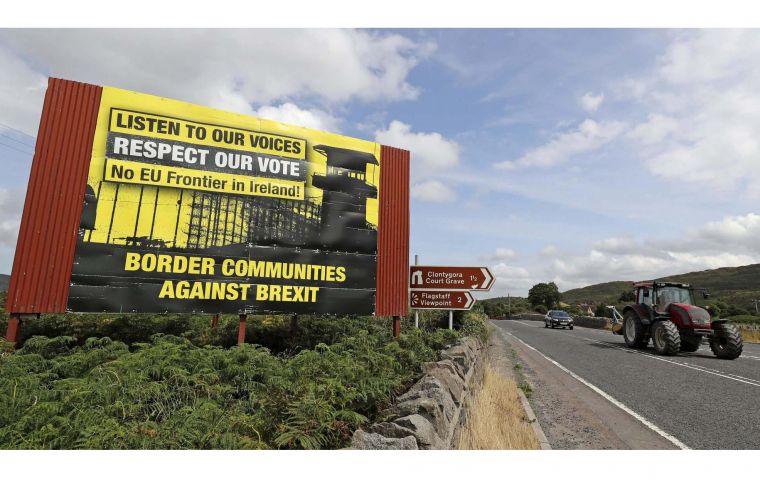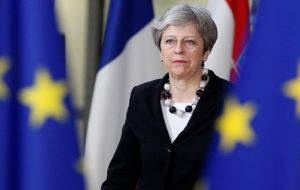MercoPress. South Atlantic News Agency
Brexit dead end: reigniting the armed conflict in Ireland?
 The border has been invisible since signing the Good Friday agreement in 1998 ended 30 years of bloody conflict between Protestant and Catholic communities
The border has been invisible since signing the Good Friday agreement in 1998 ended 30 years of bloody conflict between Protestant and Catholic communities  British and EU negotiators say that the deal is “95% agreed”, but the other 5% is the border between Ireland (EU member) and Northern Ireland (part of the UK)
British and EU negotiators say that the deal is “95% agreed”, but the other 5% is the border between Ireland (EU member) and Northern Ireland (part of the UK)  When the ‘Leave’ side narrowly won the Brexit referendum in UK and Theresa May replaced David Cameron as prime minister in 2016
When the ‘Leave’ side narrowly won the Brexit referendum in UK and Theresa May replaced David Cameron as prime minister in 2016 It was either ignorant or irresponsible for those campaigning for Brexit two years ago to claim that the Irish border would not be a problem. In fact, it may lead to a catastrophic ‘no deal’ Brexit in which the United Kingdom crashes out of the EU without an agreement of any kind.
Both the British negotiators and their EU counterparts say that the deal is “95 per cent agreed”, but the other five per cent is the border between the Republic of Ireland (an EU member) and Northern Ireland (part of the UK and therefore soon NOT part of the EU). Time is running out, and agreement on that last five per cent is far from certain.
The border has been invisible since the signing of the Good Friday agreement in 1998 ended 30 years of bloody conflict between the Protestant and Catholic communities in Northern Ireland. Three thousand people had been killed, but the situation had reached stalemate. The Good Friday deal let both sides accept that fact.
For the (Catholic) nationalists in Northern Ireland, a completely open border with the (Catholic) Republic was a vital part of the deal. It implicitly acknowledged that the two parts of the island might one day be reunited, although not now.
As the 1998 agreement plainly said, people born in Northern Ireland have the right to be “Irish or British or both as they may so choose”. And it worked, sort of: the only way you can tell you have crossed the border now is that the speed signs change from miles to kilometers or vice versa.
It was a brave, imaginative deal that has given Northern Ireland twenty years of peace, but it is now at risk. When the ‘Leave’ side narrowly won the Brexit referendum in the UK and Theresa May replaced David Cameron as prime minister in 2016, she had a credibility problem.
Like Cameron, she had supported ‘Remain’, but the Conservative Party she now led was dominated by triumphant Brexiters.
So she became an enthusiastic Brexiter herself. The English nationalists who ran the Brexit campaign had said nothing about leaving the EU’s ‘single market’ and customs union, but within weeks of taking office May declared that Britain must leave both of them.
She even made this demand part of her famous ‘red lines’, the non-negotiable minimum that the British government would accept in the divorce settlement. Unfortunately, ending the customs union would mean re-creating a ‘hard’ border between Northern Ireland and the Republic – and that might lead to a renewal of the sectarian civil war between Catholics and Protestants in the North.
It’s not clear when the Conservative government in London realized that the Irish border was going to be the biggest stumbling block on the road to Brexit, and the party’s more extreme Brexiters are still in denial about it. But the Republic will stay in the EU, and it insists that there must be no hard border after Brexit. Ireland has seen enough killing.
No hard border is therefore an EU red line, and it’s impossible to square that with May’s decision to leave the EU customs union. If there is no customs union, then there have to be border checks. And maybe a new war in the North.
So the EU suggested a ‘backstop’. If London and Brussels can’t come up with a free-trade deal to keep the border soft (i.e. invisible), then Northern Ireland could stay in the customs union, and the rest of the UK could leave. The real border, for customs purposes, could run down the middle of the Irish Sea.
Theresa May actually signed up to this solution last December, because the only real alternative is a hostile Brexit that simply ignores the EU’s position. But no sooner had she agreed the ‘backstop’ with the EU than rebels in her own camp – extreme Brexiters and members of a small Northern Ireland-based Protestant party whose votes are all that keeps the Conservatives in power – forced her to repudiate it.
Now May’s position is pure fantasy: no customs border with the EU either on land or in the Irish Sea. Which is why the probability of a chaotic ‘no deal’ Brexit is growing daily, and the prospect of renewed war in the North is creeping closer.
Is renewed war really possible? Last year Sinn Fein, the leading Catholic party in Northern Ireland, withdrew from the ‘power-sharing’ government mandated by the Good Friday agreement. That could be seen as clearing the decks for action once it became clear that Brexit would undermine all existing arrangements in Ireland.
And if the UK crashes out of the EU without a deal, the ratings agency Standard and Poor’s predicted this week, unemployment in the UK will almost double, house prices will fall by ten per cent in two years, and the British pound will fall even further. First impoverishment for the British, then war for the Irish.
By Gwynne Dyer
Dyer’s new book is ‘Growing Pains: The Future of Democracy (and Work)’




Top Comments
Disclaimer & comment rulesCommenting for this story is now closed.
If you have a Facebook account, become a fan and comment on our Facebook Page!